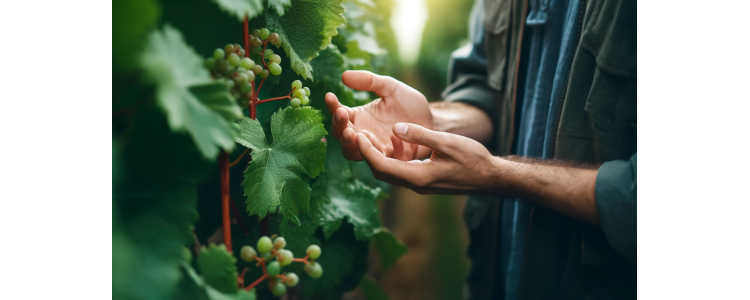Grape variety 100% Trebbiano Origin of the vine The origin of the vine is very ancient: proof of this is that the writer Andrea Bracci (1595), in his work De naturali vinorum historia de vinis italiae, refers to the Trebulano wine that the Romans indicated as wine coming from the city of Trebula (today Treglia ŌĆō Campania). Sante Lacerno, the bottler (sommelier) of Pope Paul III (1549), in speaking of Trebbiano writes: "Trebbiano [ŌĆ”] This sort of wine is delicate to drink [ŌĆ”] golden, with a not too sharp, sweet smell , not sweet, not aggressive [ŌĆ”] . His Holiness gladly drank them in the autumn between the new and old seasons." Latin writers, including Pliny, used the term Trebulans (Trebbiano) to indicate what we now call local wine (farmhouse, farmhouse). It is a vine with a great production capacity and adaptability to different types of soil and climatic conditions. The various Trebbiano vines take their names from the area of origin or from the area of greatest diffusion: we recall the Trebbiano Abruzzese, Toscano, Romagnolo, Modenese, Spoletino, di Soave. These form several DOCs (including Trebbiano d'Abruzzo). The wine obtained from Trebbiano d'Abruzzo grapes is characterized by a vinous aroma, a light golden yellow color with greenish reflections, moderately acidic, fruity, dry and harmonious. Training form Tendone or in the local dialect ŌĆ£la capanneŌĆØ. Traditional expanded cultivation of the area which is characterized by a low density of plants per hectare ( 1.100-1.600 ) capable of supporting the natural harmony of the vegetative development of the vine. In the "huts" the harvesting and pruning are exclusively manual, closely linked to the winemaker and the small peasant property. Soil and Altitude Deep clayey soils with calcareous veins. Vineyards cultivated at 400-500 m slm level Type of Biodynamic Agricultural Management with DEMETER certification.
Biodynamic cultivation is important for the microbiological life of the soil which is fundamental in the spontaneous fermentation of biodynamic wine. In conventional agriculture, the use of fungicides weakens yeast populations and makes spontaneous fermentation very difficult. Biodynamics restores the place of origin to the wine, defined by the French as "Terroir" (territoriality). Vinification
SPONTANEOUS FERMENTATION For millennia, fermentations have taken place spontaneously triggered by yeasts present in nature, the so-called indigenous or autochthonous or wild yeasts, different from area to area capable of transmitting the unique characteristics of the place and the vintage to the wine.
WHAT KILLED SPONTANEOUS FERMENTATION? Spontaneous fermentations, linked to wild yeasts, got into trouble with the diffusion of pesticides, chemical fertilizers and herbicides in the early 60s which annihilated the microbiological life of our vineyards, forcing us to resort to selected yeasts for starting the fermentation. Only with careful and clean agriculture, the result of a synergistic relationship with nature, it will be possible to bring healthy and microbiologically "alive" grapes to the cellar, therefore capable of facing a spontaneous fermentation and a winemaking process free of forcing and constraints, for a true expression of the terroir. Fundamental for the success of a spontaneous fermentation is also that the winemaking technique is respectful of microbial life: the addition of sulphites on the grapes or in the musts kills the grape microflora (yeasts) and compromises the fermentation. This is the reason why spontaneous fermentation can only be carried out without the addition of sulphites while conventionally the use of sulphite-tolerant industrial yeasts allows for fermentation also with the addition of sulphites.
TERROIR AND MICROBIAL BIOGEOGRAPHY Biodynamic wines link their complexity to spontaneous fermentation where in the first phase of fermentation the apiculated yeasts impart to the wine the fingerprint of the microbial terroir through unique organoleptic profiles. In conventional fermentation, the apiculated yeasts are not allowed to express themselves as they are eliminated with the sulphites and with the strong colonization of the added industrial yeasts.
NATURAL TARTARIC STABILIZATION Finding small crystals (tartrates) in the bottle means that "the wine felt cold" and that it released harmless natural precipitations. In biodynamic wine, physical (refrigeration) and chemical (addition of carboxy-methyl-cellulose, meta-tartaric acid, gum arabic and other) treatments are not allowed and only winter cold is used as an element of tartaric stabilization. The conventional tartaric stabilization technique provides that the wine must be brought from room temperature to around -6/-7 ┬░C before being bottled and kept at this temperature for a few days (6-7). The conventional tartaric stabilization technique, especially in the summer period, leads to a considerable energy consumption. A real pity this enormous energy consumption to avoid the presence of a few milligrams of harmless tartrate crystals.
LIMITS OF SULFITES Limit of biodynamic wine Demeter = white wine max 90 mg/lt
FILTRATION Sterile filtration is not permitted. AGING Cement tanks and bottle. sensory characteristics
ORGANOLEPTIC PROFILE Colour: straw yellow with greenish reflections, lively and crystalline. Bouquet: hints of white flowers and fresh fruit in the nose, it is pleasant and quite aromatic. Taste: elegant on the palate, fresh and harmonious.
FOOD PAIRING Seafood, cod, first courses with light sauces, white meats. SERVE AT 10-12┬░C
Data sheet
| Grape variety | Trebbiano |
|---|---|
| Alcoholic strength | 13.0% |
| Format | 750 ml |
| Name | Trebbiano d'Abruzzo |
| Vintage | 2024 |
| Disciplinary | D.O.C. |
| Region | Abruzzo |






